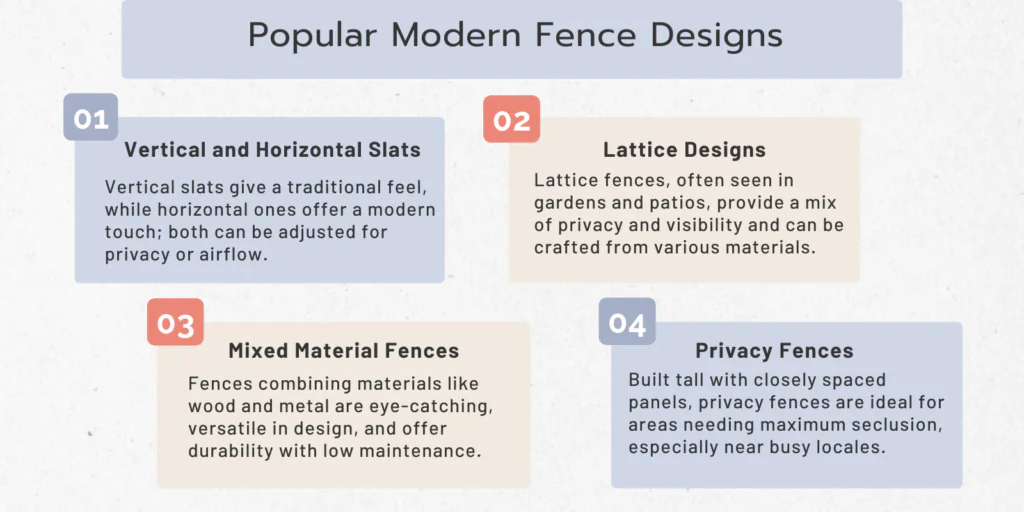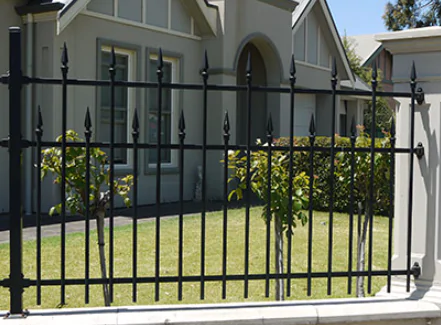Are you struggling to choose the suitable fence material and design for your property? With an overwhelming number of options available, it’s easy to feel lost. The good news is you’re not alone, and there’s a solution tailored for you.
Modern fencing materials and designs have evolved to meet various needs—security, aesthetics, and durability. There’s something for everyone, from traditional wood to advanced composites and simplistic designs to intricate patterns. Stick around, as this comprehensive guide will walk you through everything you need to know about modern fence materials and techniques for 2023. You’ll leave with knowledge and confidence to make the best choice for your unique needs.
Advancements in Fence Materials
Traditional Fence Materials
| Wood | Wood has been a staple in fencing for centuries. Its natural look and feel make it a popular choice for residential properties. Various types of wood, like cedar, pine, and redwood, offer different durability and aesthetics. However, wood fences require regular maintenance, like painting or staining, to prevent decay. |
| Metal | Metal fences, usually made of iron, aluminum, or steel, are known for their durability and strength. They are commonly used in commercial settings or areas requiring high security. While metal fences are low-maintenance, they can be expensive to install and are not always the most visually appealing. |
| PVC | PVC or vinyl fences are a modern alternative to wood, offering similar aesthetics with less maintenance. These fences resist weather conditions but can become brittle over time, especially in colder climates. |
Modern and Innovative Fence Materials
Composite Materials
Composite fencing blends plastic and wood fibers, offering the best of both worlds. These fences are incredibly durable, almost maintenance-free, and come in various designs and colors. I’ve seen firsthand how well these fences hold up over time, making them a reliable choice for investing in long-term solutions.
High-Tech Plastics
High-density polyethylene (HDPE) and other advanced plastics are entering the fencing market. These materials are lightweight, durable, and can mimic the look of more traditional materials. They also resist UV rays and harsh weather conditions, requiring minimal upkeep.
Eco-Friendly Materials
Sustainability is a growing concern, and the fencing industry is adapting. Eco-friendly materials like bamboo and recycled plastics offer a guilt-free fencing solution. These materials are not only sustainable but also durable and aesthetically pleasing.
Benefits and Drawbacks of These Modern Materials

- Durability
Modern materials like composites and high-tech plastics are designed to last. They are resistant to rot, decay, and insect infestations, making them a long-lasting option. This durability is something I can vouch for, having worked with these materials on various projects.
- Maintenance
One of the significant advantages of modern fencing materials is the low maintenance requirement. Most of these materials only need an occasional wash to keep them looking new. No need for annual staining or painting, saving you both time and money.
- Cost
While modern materials may have a higher upfront cost, their durability and low maintenance often make them more cost-effective in the long run. However, it’s essential to consider your budget and how much you’re willing to invest initially.
- Aesthetics
Modern fencing materials come in a variety of designs and colors, allowing for greater customization. Whether you’re looking for something minimalistic or a fence that makes a statement, there’s likely a modern material that fits the bill.
Modern Fence Designs
Evolution of Fence Designs
Fence designs have come a long way from their utilitarian origins. What started as a simple means of marking boundaries and keeping livestock in place has evolved into an art form that complements architecture and enhances the aesthetics of a property. Today, fences serve multiple purposes, including security, privacy, and visual appeal, thanks to the industry’s creative minds and technological advancements.
Popular Modern Fence Designs

- Vertical and Horizontal Slats
The orientation of slats in a fence can dramatically change its appearance. Vertical slats offer a traditional look, while horizontal slats provide a modern, sleek aesthetic. Both styles can be spaced tightly for privacy or loosely to allow light and air to pass through. Having installed both types for various clients, I can attest to their versatility and appeal.
- Lattice Designs
Lattice fences are a popular choice for those looking for a balance between privacy and openness. The crisscross pattern allows for some visibility while still offering a level of seclusion. These designs are often used in gardens and patios and can be made from wood, metal, or composite materials.
- Mixed Material Fences
Combining different materials like wood and metal or stone and glass creates a unique, eye-catching fence design. These mixed material fences are becoming increasingly popular for their ability to match various architectural styles while providing functional benefits like durability and low maintenance.
- Privacy Fences
Privacy fences are designed to offer maximum seclusion. They are usually tall, with tightly spaced slats or panels, and are often made of solid materials like wood or composite. These fences are ideal for properties that require a high level of privacy, such as homes near busy streets or commercial areas.
Importance of Choosing the Right Design to Complement Your Home’s Architecture
The design of your fence should not be an afterthought; it should harmonize with your home’s architectural style. Whether you have a modern, minimalist home or a traditional, rustic abode, the right fence can enhance its visual appeal and even increase its market value. I’ve consulted on numerous projects where the fence design played a crucial role in tying together the property’s overall aesthetic.
How to Choose the Right Fence Material and Design

Factors to Consider Before Choosing a Fence Material
Climate
The climate in your area plays a significant role in the longevity and maintenance of your fence. For instance, wood may not be the best choice for extremely humid or wet climates as it’s susceptible to rot and decay. On the other hand, metal fences can rust in such conditions. Having worked on fencing projects across various climates, I can guide you toward materials that are well-suited for your specific environmental conditions.
Purpose of the Fence
Are you installing a fence for security, privacy, or purely aesthetic reasons? The purpose will significantly influence your choice of material. For example, if you’re looking for a strong, secure fence, metal or composite materials are your best bet. If it’s privacy you’re after, then solid wood or vinyl panels would be more appropriate.
Budget
Your budget will inevitably influence your choice of fencing material. While materials like composite and high-tech plastics offer long-term benefits, they come with a higher upfront cost. On the other hand, wood and metal are generally more budget-friendly but may require more frequent maintenance.
Factors to Consider Before Choosing a Fence Design
| Home’s Architectural Style | Match your fence design to your home’s style for aesthetic harmony. |
| Local Regulations | Check local laws and association guidelines to avoid fines or redesigns. |
| Maintenance Requirements | Choose a fence based on your willingness for upkeep; simpler designs often require less maintenance. |
- Home’s Architectural Style
Your home’s architectural style should be a guiding factor in choosing a fence design. A modern, sleek design may not suit a traditional home, and vice versa. Over the years, I’ve helped homeowners select designs that not only meet their functional needs but also complement their home’s architecture.
- Local Regulations
Before you finalize a design, it’s crucial to check local zoning laws and homeowners association guidelines, if applicable. Some areas have height restrictions, while others may require specific materials. Failing to adhere to these regulations can result in fines or the need to modify or remove the fence.
- Maintenance Requirements
Different fence designs have varying maintenance needs. For example, a simple vertical slat design may be easier to clean and maintain than a more intricate lattice design. Consider how much time and effort you’re willing to invest in upkeep when choosing a design.
Conclusion
The world of fencing has seen remarkable advancements in both materials and designs. From traditional wood and metal to modern composites and high-tech plastics, the options are more diverse and functional than ever. Designs have also evolved, offering a range of styles from simple slats to intricate lattice patterns.
But remember, the best fence for you is one that meets your specific needs—be it security, privacy, or aesthetics. So, take your time to weigh the pros and cons of each material and design. Trust me, a well-thought-out decision will not only enhance your property’s curb appeal but also stand the test of time. Choose wisely and invest in a fence that you’ll be proud of for years to come.


